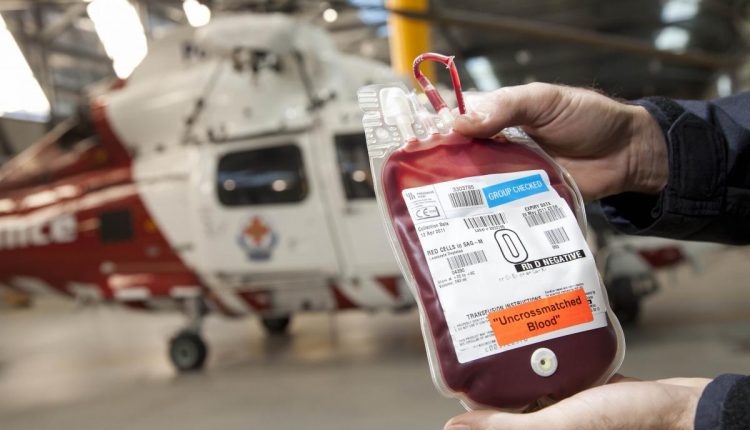
Haemotransfusion in Emergencies, when the question is: "What is the patient's blood type?"
The universal recipient blood type is AB positive (also written as AB+). This means that an AB+ person can safely receive a blood transfusion with any of the other blood types
Matching the correct blood type is key to a safe blood transfusion or organ transplant
If a person receives the wrong blood type, the body treats it as foreign.
The immune system attacks the donated blood cells rather than accepting them into the body.
Such an attack can lead to serious problems including kidney failure and shock.
In rare cases, receiving an incompatible blood donation can be fatal.2
This article reviews how blood typing works and why donor blood types need to be a safe match for their recipients.
It also discusses the type-related or allergic reactions that can occur with blood transfusions.
Blood Types
Antigens on blood cells are what determine how a blood recipient reacts to a transfusion.
An antigen is any substance the immune system can respond to.
If the immune system detects an antigen that is not found on the body’s own cells, it will set off an attack to fight it.3
There are seven blood types in addition to the universal recipient type.
They are O positive, O negative, A positive, A negative, B positive, B negative, and AB negative.
This means that:
- O blood types are unique in that they have no antigens. O negative blood is considered the universal blood donor type. It is compatible with all A, AB, B, and O positive blood types.
- If you have blood type A, you have an A antigen.
- If you have blood type B, you have a B antigen.
- The AB blood type means that both of the antigens for A and B blood are present. It is the rarest blood type. A person with AB blood has all of the antigens that are possible.
- The universal donor blood type is O negative. Anyone with this type can donate blood to a person who needs it, regardless of the recipient’s blood type.
Blood types are described as positive or negative
This is based on the presence or absence of a protein called Rh factor.
This factor is often expressed as a “+” (positive, or present) or “-” (negative, or absent) when identifying a person’s blood type.
Rh-negative blood is given to Rh-negative patients.
Rh-positive or Rh-negative blood may be given to Rh-positive patients.4
Since both A and B antigens are present in a person with AB positive blood and it has a positive Rh factor, the recipient won’t reject the blood.
Blood type compatibility: Blood Transfusion Reactions
A person may have a reaction if they receive the wrong type of blood.
An allergic reaction to the blood transfusion is also possible, regardless of the blood type.
A hemolytic transfusion reaction can occur when there is a mismatch between A, B, and O blood types of the donor and recipient.
Antibodies in the recipient’s blood attach to the donor red blood cells.
The cells are then destroyed in the recipient’s bloodstream, liver, and spleen.
Sometimes, this can lead to jaundice, or a yellow tint to eyes and skin.
It also may cause uncontrolled clotting in the bloodstream, shock, and rarely death.5
These reactions are divided into two categories: acute and delayed hemolytic reactions.
Acute reactions happen within 24 hours of a transfusion.
Delayed reactions come later, and may happen two weeks to 30 days after a transfusion.6
Hospital blood banks type and crossmatch each unit of blood to be given to a recipient, so these reactions are rare.
Also known as an acute non-hemolytic transfusion reaction, the symptoms of this type of reaction include:7
- Itching
- Fever
- Chills
- Skin rash
The symptoms of this type of reaction often pass in a day or two.
It can be treated effectively by stopping the transfusion.
The person is then given an antihistamine drug such as Benadryl (diphenhydramine).
A person who has a severe type of reaction to a blood transfusion may need to have more carefully screened blood in the future.
This is done to prevent a similar reaction with later transfusions.
Bibliographic references:
- National Cancer Institute. ABO blood group system.
- Dean L. Chapter 3, Blood transfusions and the immune system. In: Blood Groups and Red Cell Antigens [Internet]. Bethesda (MD): National Center for Biotechnology Information (US).
- Dean L. Chapter 2, Blood group antigens are surface markers on the red blood cell membrane. In: Blood Groups and Red Cell Antigens [Internet]. Bethesda (MD): National Center for Biotechnology Information (US).
- Red Cross. Facts about blood and blood types.
- Delaney M, Wendel S, Bercovitz RS, et al. Transfusion reactions: Prevention, diagnosis, and treatment. Lancet. 2016;388(10061):2825-2836. doi:10.1016/S0140-6736(15)01313-6
- Harewood J, Ramsey A, Master SR. Hemolytic transfusion reaction. In: StatPearls [Internet]. Treasure Island (FL): StatPearls Publishing.
- Suddock JT, Crookston KP. Transfusion reactions. In: StatPearls [Internet].
- Cedars-Sinai. ABO incompatibility in transplants.
- Cleveland Clinic. Blood transfusion.
Read Also:
Emergency Live Even More…Live: Download The New Free App Of Your Newspaper For IOS And Android
What To Do With Trauma In Pregnancy – A Brief List Of Steps
Blood Transfusion In Trauma Scenes: How It Works In Ireland
TRALI (Transfusion-Related): A Serious But Rare Transfusion Complication
Blood Transfusion: Recognising Transfusion Complications
Hypovolaemia: Causes, Symptoms, Diagnosis And Intervention
FDA Issues Alert Medication Infusion Pump Hacking Alert


